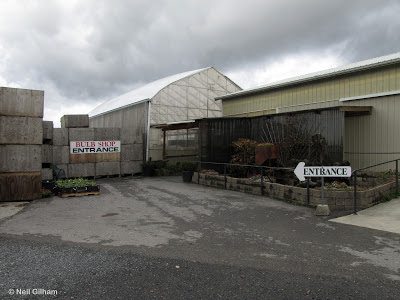The Skagit Valley Bulb Farm (aka Tulip Town) is where we always buy the bulbs. These are fresh, fat bulbs, unlike any you find on the rack at Home Depot. Here you can also pick as many fresh, ripe apples as you can carry out from the rows of espaliered apple trees.
After our big bulb purchase, we decided to wander north. When you roll through the Skagit Valley it's best not to have a plan, just drive along the roads and sooner or later something will pull you in. And so it was with the Padilla Bay - Breazeale Interpretive Center. The center has a small museum jam-packed with information about the ecology of Padilla Bay and the Salish Sea. You get the feeling that eel grass is pretty much the crux of the ecosystem here. The museum has several beautiful and impressive aquariums, well stocked with the local sea life. This is all part of the Padilla Bay National Estuarine Research Reserve and so there's research going on here and a laboratory (not open to the general public).
We decided to follow the loop trail that begins just outside of the center at the edge of the parking lot. The trail is about a mile in length and gently ascends through the upland area behind the center. It's aptly named the Upland Trail. It's an easy wide trail perfect for young kids and octogenarian mothers. There was nobody on this trail when we were there on a cool cloudy wanting-to-rain fall day.
We also explored the short trail to the beach that dives through a tunnel under the road with a final plunge on a spiral staircase that gets you right down on the beach. We were here at high tide so there wasn't much beach. At low tide Padilla Bay is a huge tidal mud flat.
The final stop was the Skagit River Brewery in Mount Vernon for good grub chased down with a glass of their Highwater Porter.
In the Skagit Valley, go with the flow. You'll never know where you'll end up.
Next photos:
It all starts at the Donut House in Anacortes.
Skagit Valley Bulb Farm
Skagit Valley barn.
Skagit Valley autumn colors on a row of old buckeye trees.
Padilla Bay - Breazeale Interpretive Center.
Amazing sea creatures ... found locally.
Red sea urchin
The Upland Trail at Padilla Bay - Breazeale Interpretive Center.
(derived from http://www.gmap-pedometer.com)
(derived from http://www.gmap-pedometer.com)
On the Upland Trail, looking back to the Padilla Bay - Breazeale Interpretive Center.
On the Upland Trail, looking out over Padilla Bay, the March Point refineries, and Mount Erie.
On the Upland Trail.
Friends you'll see on the Upland Trail.
The woods along the Upland Trail
Fall rose hips along the Upland Trail.
Dangers along the Upland Trail.
Take a rest on the Upland Trail.
Lummi Island from the beach access.
Great way to end the day.








































